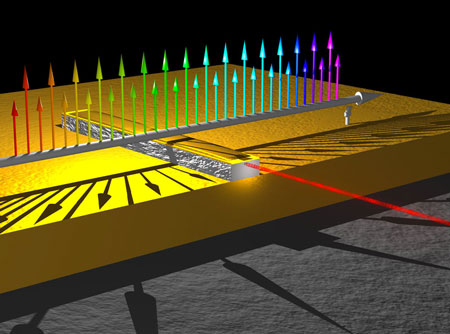| Dec 13, 2012 |
Cutting light with a comb
|
|
(Nanowerk News) Imagine a small, handy measuring device which environmental officers at an industrial plant can use to monitor their production facility’s wastewater; a device that analyses the contaminants dissolved in the water in seconds and sounds the alarm if the concentration is above the safety limit. Or imagine a portable device that an airport’s security force can use to analyse the air in the event of a terrorist threat. The apparatus would even be capable of recognising minute traces of poison gas reliably. Analytic devices with these functions exist on a large scale in specialist labs.
|
|
“However, there are hardly any portable versions of them,” says Andreas Hugi, a doctoral student from ETH Zurich. “And they mostly have mobile mechanical elements, thus the accuracy and reliability suffers.”
|
|
Together with his colleagues from the group of Jérôme Faist, professor of quantum electronics, Hugi has now discovered special properties in a very small, broadband laser, thanks to which it should be possible to build small, yet accurate, analysis devices – so-called spectrometers – with such lasers in the future ("Mid-infrared frequency comb based on a quantum cascade laser").
|
|
The physics behind the method: molecules that are gaseous or dissolved in liquid absorb infrared light of specific wavelengths, displaying a characteristic absorption spectrum. This absorption is used in spectrometry. Infrared light is sent through liquid or gas samples and the proportion of this light that can penetrate the sample is analysed. The colour spectrum obtained indicates the substances.
|
 |
| Thanks to its frequency comb properties, a small laser could make it big. (Illustration: Andreas Hugi/ETH Zurich)
|
|
Millimetre-sized laser sources
|
|
In the ETH-Zurich researchers’ approach, the light sources for spectrometry are so-called quantum cascade lasers, which produce light in precisely the range where the absorption spectrum is found: the mid-infrared range. These light sources are merely seven millimetres in size. Such lasers have been around for some time: ETH-Zurich professor Faist developed the first of its kind almost twenty years ago in the Bell Labs in the USA. Today, his group is one of the leading teams in the development of broadband lasers. The light of these lasers is not one colour in particular, but upon closer inspection, composed of hundreds of similar colours.
|
|
Researchers of Faist’s group now have studied such a light source in the mid-infrared spectrum. As the scientists discovered, the frequencies of these hundreds of similar colours are precisely defined and at regular intervals. “Much like the centimetre markings on a ruler,” explains Hugi. “In a laser source, this is known as a frequency comb.” It was not previously known that mid-infrared quantum cascade lasers can have such a frequency comb. In their paper published in the journal Nature, the ETH-Zurich scientists present the first frequency comb generated by a mid-infrared quantum cascade.
|
|
Trick with two lasers
|
|
For the physicists to be able to use such quantum cascade laser frequency combs together with a light detector as a spectrometer in the future, they have a trick up their sleeves: they want to combine two quantum cascade laser frequency combs with slightly different frequency spacing. “Just as acoustic beating can occur with musical instruments that haven’t been tuned to each other, there is also beating with the two different frequency combs – albeit of an optical nature,” says Hugi. The absorption spectrum of the samples studied can be calculated from this beating using mathematical methods. “This means an entire spectrum can be recorded in a matter of seconds in the future,” says the doctoral student. First of all, however, more development work is necessary. For example, the laser studied only has the properties of a frequency comb in part of its reachable colour spectrum. For an application in spectrometry, it would be preferable to refine the laser further to increase the size of this range.
|
|
The reason why existing spectrometers that are able to record entire absorption spectra are much bigger is that they use a different technique. They do not usually use a laser as a light source, but rather a relatively weak light bulb. Only through an elaborate optical measuring set-up with movable mirrors is it possible to obtain an absorption spectrum. The bigger the measuring set-up, the more accurate the analyses – and vice versa. Consequently, according to Hugi, the miniaturisation of devices with the existing technology is very limited. It is a different story altogether with the millimetre-sized quantum cascade laser, which is controlled electronically and whose resolution does not depend on an optic set-up.
|

